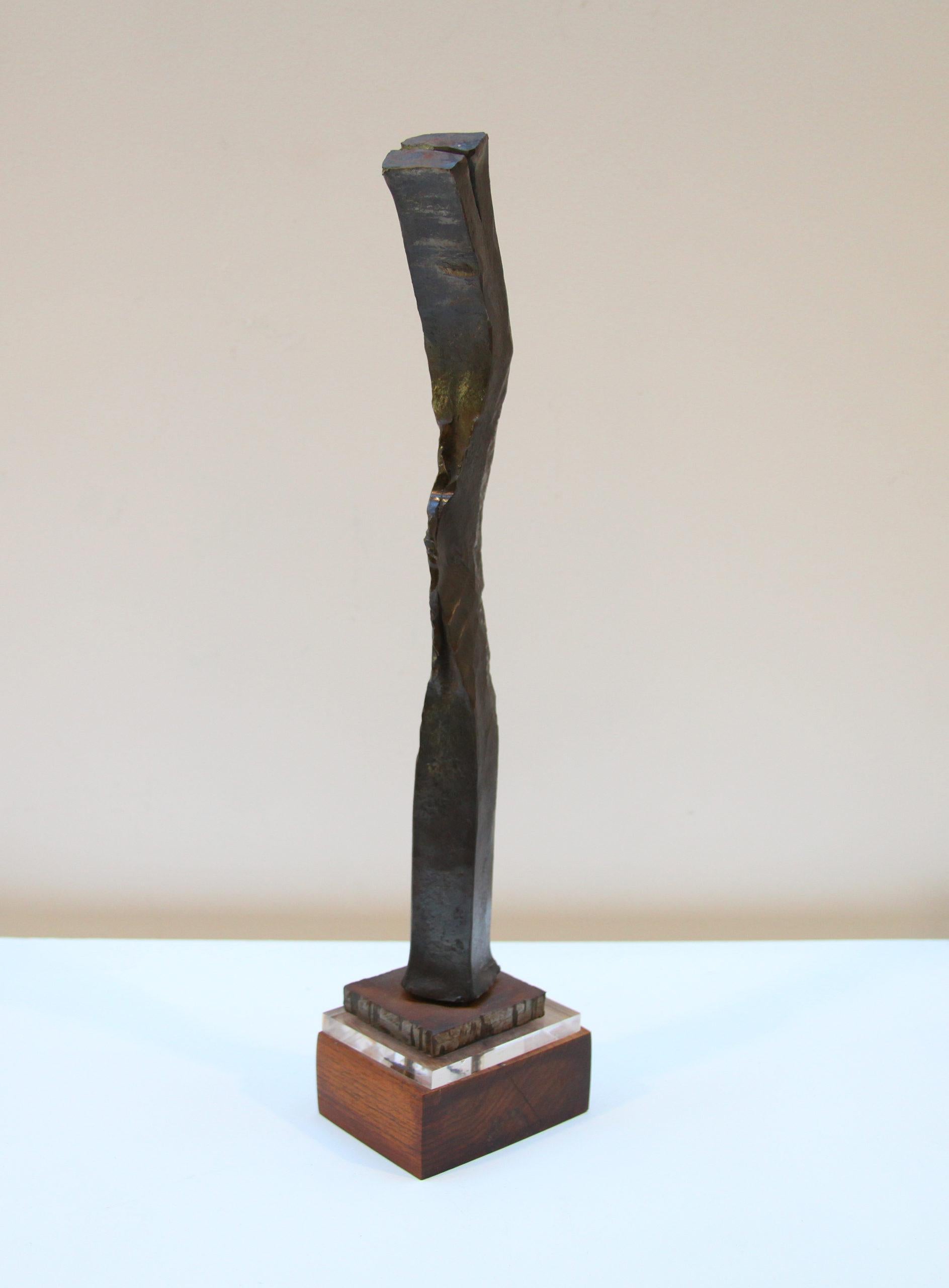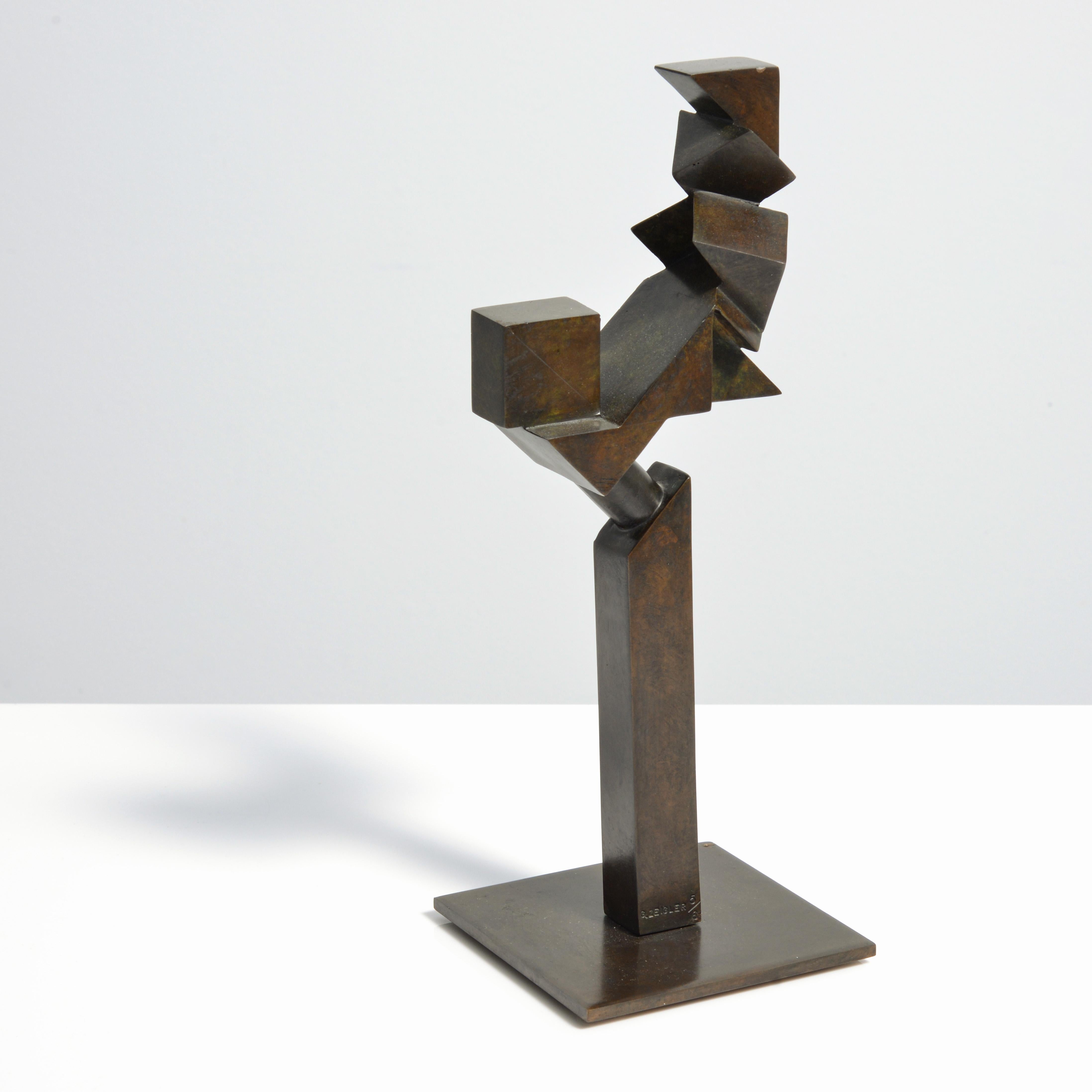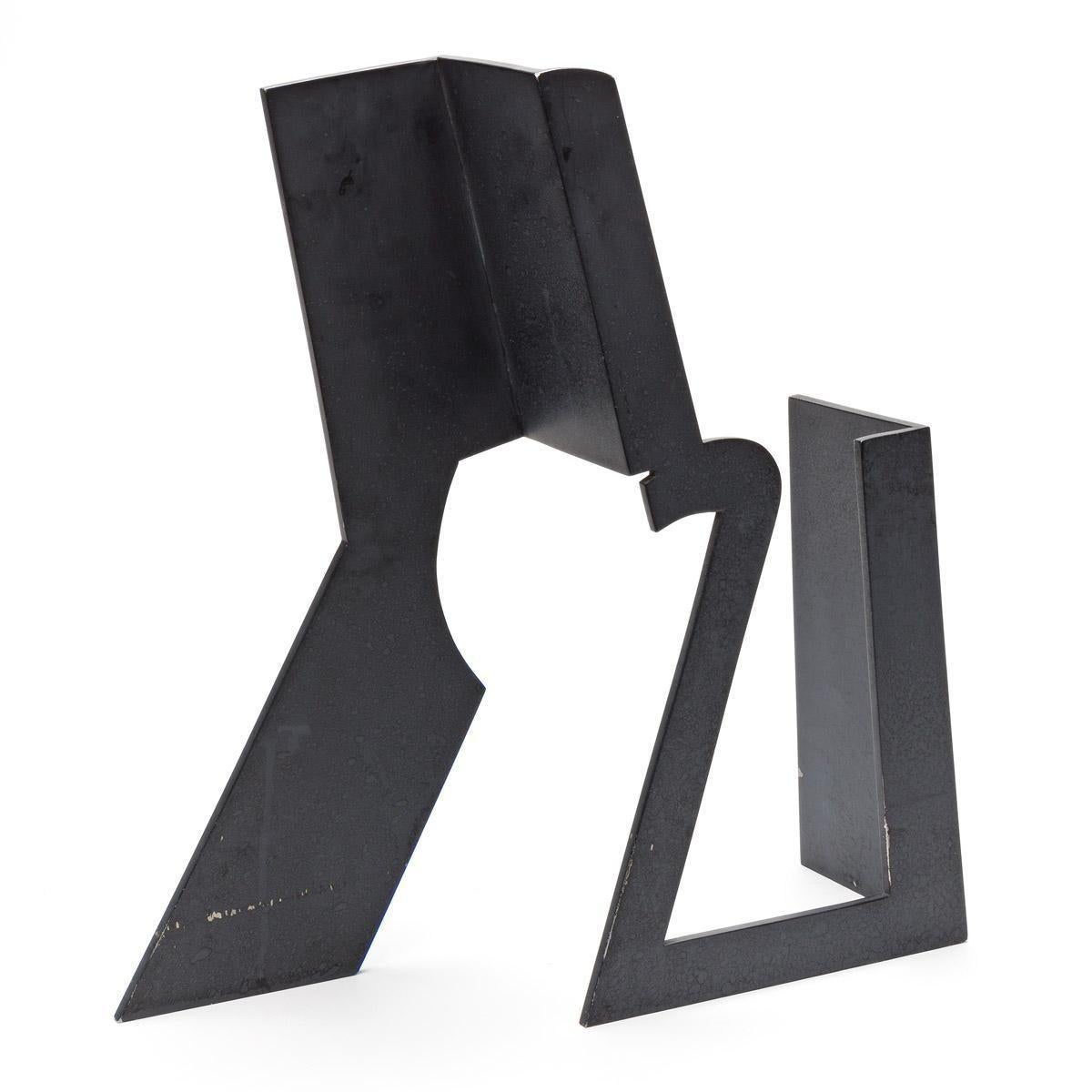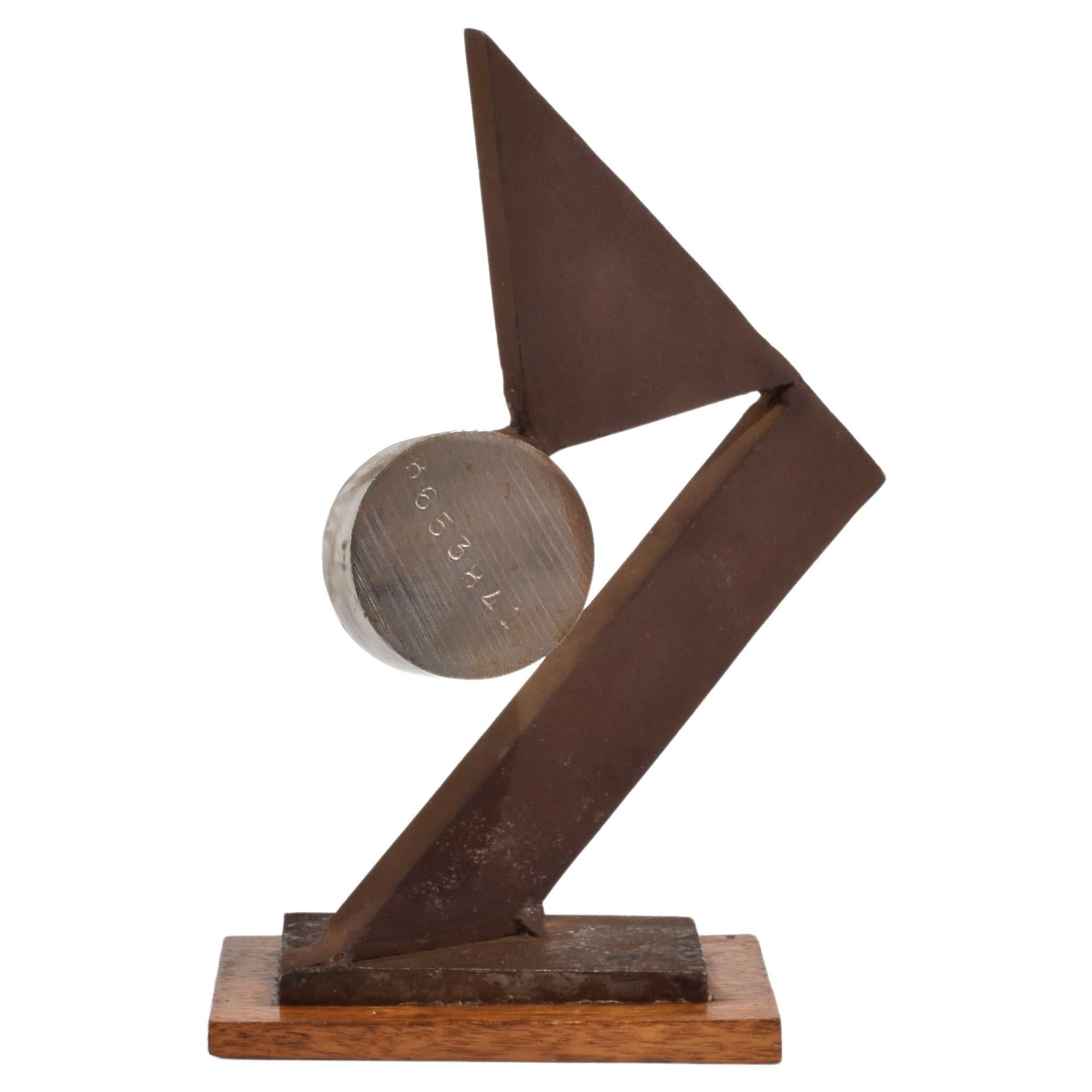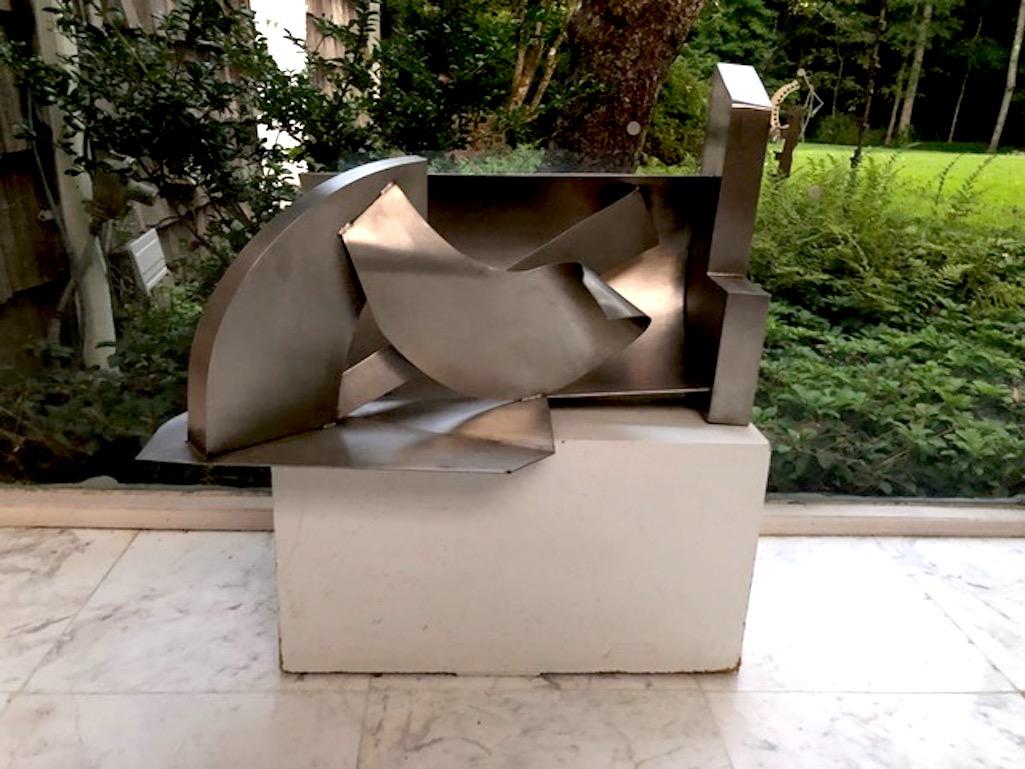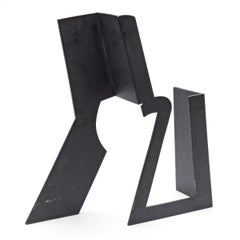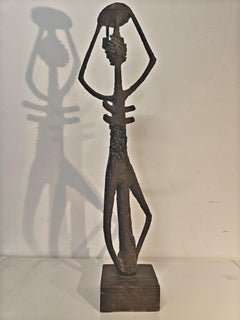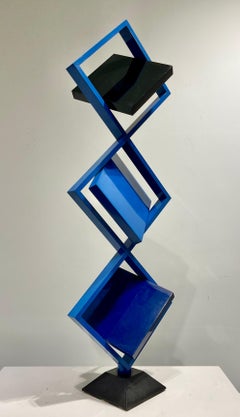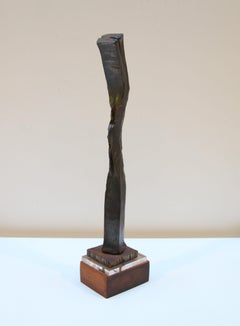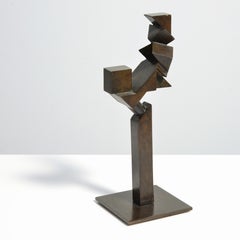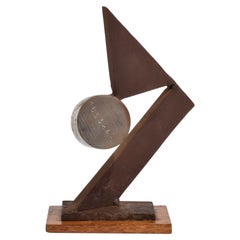Items Similar to "Untitled" Sidney Gordin, Abstract Metal Steel Sculpture
Want more images or videos?
Request additional images or videos from the seller
1 of 6
Sidney Gordin"Untitled" Sidney Gordin, Abstract Metal Steel Sculpture1958
1958
$11,200
$14,00020% Off
£8,427.76
£10,534.7020% Off
€9,743.13
€12,178.9120% Off
CA$15,814.72
CA$19,768.4020% Off
A$17,147.79
A$21,434.7420% Off
CHF 9,100.13
CHF 11,375.1620% Off
MX$211,196.84
MX$263,996.0520% Off
NOK 112,790.37
NOK 140,987.9720% Off
SEK 106,448.18
SEK 133,060.2320% Off
DKK 72,725.13
DKK 90,906.4120% Off
About the Item
Sidney Gordin
Untitled, 1958
Incised with initials
Welded Steel
15 x 10 1/2 x 6 inches
Provenance:
Eric Firestone Gallery, New York
On October 24, 1918, Sidney Gordin was born in Chelyabinsk, Russia. He spent his early years in Shanghai, China. At the age of four, he moved with his family to New York. Gordin’s nephew, Eliot Nemzer recalls that when Gordin was a child he attended “a dinner party with his parents. Someone showed him a book of pictures that when thumbed through quickly made the image appear to move. This person then gave him a wad of blank papers and something to write with. Sid created a similar type of moving image with his materials. All the adults at the party became quite excited [and] praised his efforts. Sid told me he thought this was a pivotal experience in guiding him towards his vocation.” During his formative years at Brooklyn Technical High School, he briefly contemplated the idea of becoming an architect; yet, by the time he enrolled at Cooper Union, he was determined to become a professional artist. There, he studied under Morris Kantor (1896-1974) and Leo Katz (1887-1982), devoting much of his class schedule to drawing and painting.
In 1949, Gordin turned his attention to sculpture for the first time. Three years later, he held his first solo-exhibition at Bennington College in Vermont and the Peter Cooper Gallery in New York. That same year he was accepted into the Metropolitan Museum of Art’s group exhibition American Sculpture 1951. His metal and wire constructions were shown alongside such sculptors as Alexander Calder (1898-1976), William Zorach (1887-1966), and George Rickey (1907-2002). Over the following years, he regularly exhibited in the annual exhibitions of the Whitney Museum of American Art, while also holding yearly solo-exhibitions at the Grace Borgenicht Gallery in New York. Three days into his first solo-exhibition at Borgenicht in 1953, the Whitney made their first acquisition of his work by purchasing a metal construction for their permanent collection.
By the late 1950s, he began to employ wood in his sculptures, which eventually led to the creation of painted constructions. With a renewed interest in painting, Gordin often alternated between these painted wood constructions and two-dimensional painting up until his death in the early 90s.
Following teaching stints at both Sarah Lawrence College and the New School for Social Research in New York, Gordin accepted a position at UC Berkeley’s Department of Art in 1958. Amidst the emerging Bay Area art scene, Gordin taught alongside such artists as Peter Voulkos, Joan Brown, and Jay de Feo. Coinciding with his move to Berkeley, he held his first solo-exhibition on the West Coast at San Francisco’s seminal Dilexi Gallery. In 1962, the M.H. De Young Memorial Museum in San Francisco mounted his first one-man museum show.
Yet, while maintaining his professorship at Berkeley, Gordin never completely cut his ties to the East Coast. He maintained a studio in Provincetown, Massachusetts, which he often visited throughout the years, and continued to appear in several exhibitions organized by the Metropolitan Museum of Art, the Whitney, and the Zabriskie Gallery well into the 90s. Over the next several decades, he was included in prominent group exhibitions such as the Whitney’s Precisionist View in American Art and Geometric Abstraction in America; the exhibition West Coast Now, which traveled from the Portland Art Museum to the Seattle Art Museum, the De Young, and the Los Angeles Municipal Art Gallery; and the Oakland Museum’s exhibition, Art in the San Francisco Bay Area. During the course of his career, he was also included in shows in Paris, Tel Aviv, and Tokyo.
He retired from teaching in 1986 as Professor Emeritus of Art. Following his retirement, he, along with several members of the Berkeley Art Department, founded the Breakfast Club, an eclectic mix of Bay Area artists and students that met weekly for discussions about art and politics and held regular group exhibitions for many years. Three years before his death in 1993, he was inducted as a Member of the National Academy of Design.
- Creator:Sidney Gordin (1918-1996, American)
- Creation Year:1958
- Dimensions:Height: 10 in (25.4 cm)Width: 5 in (12.7 cm)Depth: 5 in (12.7 cm)
- Medium:
- Movement & Style:
- Period:
- Condition:
- Gallery Location:New York, NY
- Reference Number:1stDibs: LU1841212443452
About the Seller
5.0
Platinum Seller
Premium sellers with a 4.7+ rating and 24-hour response times
Established in 2022
1stDibs seller since 2022
122 sales on 1stDibs
Typical response time: 1 hour
- ShippingRetrieving quote...Shipping from: New York, NY
- Return Policy
Authenticity Guarantee
In the unlikely event there’s an issue with an item’s authenticity, contact us within 1 year for a full refund. DetailsMoney-Back Guarantee
If your item is not as described, is damaged in transit, or does not arrive, contact us within 7 days for a full refund. Details24-Hour Cancellation
You have a 24-hour grace period in which to reconsider your purchase, with no questions asked.Vetted Professional Sellers
Our world-class sellers must adhere to strict standards for service and quality, maintaining the integrity of our listings.Price-Match Guarantee
If you find that a seller listed the same item for a lower price elsewhere, we’ll match it.Trusted Global Delivery
Our best-in-class carrier network provides specialized shipping options worldwide, including custom delivery.More From This Seller
View All"Roland, " George Sugarman, Abstract Steel Sculpture
By George Sugarman
Located in New York, NY
George Sugarman (1912 - 1999)
Roland, 1970
Patinated steel
17 3/8 x 16 x 5 1/4 inches
Incised with the artist's signature and numbered "15/17" on the underside
Manufactured by Lippin...
Category
1970s Abstract Abstract Sculptures
Materials
Steel
"Untitled" David Hare, Surrealist, Anthropomorphic, Modernist, Ab-Ex Sculpture
By David Hare
Located in New York, NY
David Hare
Untitled, circa 1949
Bronze
25 x 8 x 7 inches
Provenance
Kootz Gallery, New York
Collection of Samuel Kootz New York
Estate of the above
Collection of Dr. Joyce Kootz, Ne...
Category
1940s Surrealist Abstract Sculptures
Materials
Bronze
"Untitled" Beverly Pepper, Ultra Marine Blue and Steel Architectural Sculpture
By Beverly Pepper
Located in New York, NY
Beverly Pepper
Untitled
"BP" monogram stamped on the base
Stainless steel and enamel
6 x 6 3/4 x 3 1/8 inches
Born in 1922 in Brooklyn, Pepper trained to as a painter with Fernand ...
Category
1960s American Modern Abstract Sculptures
Materials
Enamel, Stainless Steel
"Kinetic Sculpture" Roger Phillips, 1985 Rotating Blue Constructivist Sculpture
By Roger Phillips
Located in New York, NY
Roger Phillips
Kinetic Sculpture
Painted iron and aluminum on walnut plinth base
44 1/2 inches high x 13 inches wide x 7 3/4 inches deep
oger Phillips was born in New York City in ...
Category
1980s Constructivist Abstract Sculptures
Materials
Enamel, Iron
"Dancer" David Hare, Male Nude, Figurative Sculpture, Mid-Century Surrealist
By David Hare
Located in New York, NY
David Hare
Dancer, circa 1955
Bronze with integral stand
68 high x 17 wide x 13 1/2 deep inches
“Freedom is what we want,” David Hare boldly stated in 1965, but then he added the caveat, “and what we are most afraid of.” No one could accuse David Hare of possessing such fear. Blithely unconcerned with the critics’ judgments, Hare flitted through most of the major art developments of the mid-twentieth century in the United States. He changed mediums several times; just when his fame as a sculptor had reached its apogee about 1960, he switched over to painting. Yet he remained attached to surrealism long after it had fallen out of official favor. “I can’t change what I do in order to fit what would make me popular,” he said. “Not because of moral reasons, but just because I can’t do it; I’m not interested in it.”
Hare was born in New York City in 1917; his family was both wealthy and familiar with the world of modern art. Meredith (1870-1932), his father, was a prominent corporate attorney. His mother, Elizabeth Sage Goodwin (1878-1948) was an art collector, a financial backer of the 1913 Armory Show, and a friend of artists such as Constantin Brancusi, Walt Kuhn, and Marcel Duchamp.
In the 1920s, the entire family moved to Santa Fe, New Mexico and later to Colorado Springs, in the hope that the change in altitude and climate would help to heal Meredith’s tuberculosis. In Colorado Springs, Elizabeth founded the Fountain Valley School where David attended high school after his father died in 1932. In the western United States, Hare developed a fascination for kachina dolls and other aspects of Native American culture that would become a recurring source of inspiration in his career.
After high school, Hare briefly attended Bard College (1936-37) in Annandale-on-Hudson. At a loss as to what to do next, he parlayed his mother’s contacts into opening a commercial photography studio and began dabbling in color photography, still a rarity at the time [Kodachrome was introduced in 1935]. At age 22, Hare had his first solo exhibition at Walker Gallery in New York City; his 30 color photographs included one of President Franklin Roosevelt.
As a photographer, Hare experimented with an automatist technique called “heatage” (or “melted negatives”) in which he heated the negative in order to distort the image. Hare described them as “antagonisms of matter.” The final products were usually abstractions tending towards surrealism and similar to processes used by Man Ray, Raoul Ubac, and Wolfgang Paalen.
In 1940, Hare moved to Roxbury, CT, where he fraternized with neighboring artists such as Alexander Calder and Arshile Gorky, as well as Yves Tanguy who was married to Hare’s cousin Kay Sage, and the art dealer Julian Levy. The same year, Hare received a commission from the American Museum of Natural History to document the Pueblo Indians. He traveled to Santa Fe and, for several months, he took portrait photographs of members of the Hopi, Navajo, and Zuni tribes that were published in book form in 1941.
World War II turned Hare’s life upside down. He became a conduit in the exchange of artistic and intellectual ideas between U.S. artists and the surrealist émigrés fleeing Europe. In 1942, Hare befriended Andre Breton, the principal theorist of surrealism. When Breton wanted to publish a magazine to promote the movement in the United States, he could not serve as an editor because he was a foreign national. Instead, Breton selected Hare to edit the journal, entitled VVV [shorth for “Victory, Victory, Victory”], which ran for four issues (the second and third issues were printed as a single volume) from June 1942 to February 1944. Each edition of VVV focused on “poetry, plastic arts, anthropology, sociology, (and) psychology,” and was extensively illustrated by surrealist artists including Giorgio de Chirico, Roberto Matta, and Yves Tanguy; Max Ernst and Marcel Duchamp served as editorial advisors.
At the suggestion of Jacqueline Lamba...
Category
1950s Abstract Figurative Sculptures
Materials
Bronze
$20,000 Sale Price
20% Off
"Untitled" Albert Heckman, Mid-Century American Modernist Abstract Composition
By Albert Heckman
Located in New York, NY
Albert Heckman
Untitled
Signed lower left
Oil on canvas
20 x 24 inches
Albert Heckman was born in Meadville, Western Pennsylvania, 1893. He went to New York City to try his hand at...
Category
1950s Modern Abstract Paintings
Materials
Canvas, Oil
You May Also Like
An Abstract Steel Metal Sculpture, "Untitled Steel Sculpture"
Located in San Diego, CA
A one of a kind 3" x 18" x 4" Abstract Steel Metal Sculpture executed by artist James Hubbell. A certificate of authenticity will be provided upon its purchase.
James Hubbell is an...
Category
2010s Abstract Abstract Sculptures
Materials
Steel
Gavin Zeigler Abstract Bronze Sculpture
By Gavin Zeigler
Located in Lake Worth Beach, FL
Artist/Designer: Gavin Zeigler (American, b. 1962)
Marking(s); notes: stamped signature; ed. 5/6
Materials: bronze
Additional Information: Sculpture
Category
20th Century Abstract Sculptures
Materials
Bronze
Abstract Mixed Metals Sculpture
Located in Richmond, VA
Vintage, handmade abstract metal sculpture on a wooden base.
Category
20th Century Abstract Sculptures
Materials
Metal
Paul Sisko Abstract Expressionist Steel Sculpture
Located in New York, NY
Paul Sisko (American, b. 1942)
Untitled, 1971
Stainless Steel
Sculpture: 18 1/4 x 6 x 4 1/2 in.
Base: 2 1/2 x 5 1/2 x 4 in.
Signed: Paul Sisko "71" 9/12
Edition 9 of 12
Paul Sisko ...
Category
1970s Contemporary Abstract Sculptures
Materials
Stainless Steel
Untitled XIII : abstract steel sculpture
Located in New York, NY
Abstract steel sculpture by Naomi Press. Signed with initials.
Naomi Press is a female abstract sculptor, who was one of the very few women working in large scale with steel in the ...
Category
1980s Abstract Abstract Sculptures
Materials
Stainless Steel
Noteworthy - Original Contemporary Expressive Geometric Abstract Metal Sculpture
By Granville Beals
Located in Los Angeles, CA
Inspired by dance and weightlessness, Granville Beals' industrial metal sculptures are primarily about relationships. Concerned with form and abstraction, he does not merely manipula...
Category
21st Century and Contemporary Abstract Abstract Sculptures
Materials
Metal, Steel
